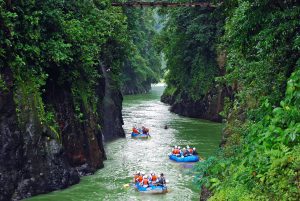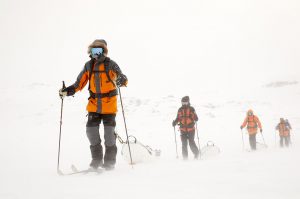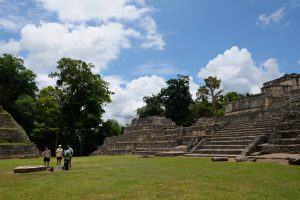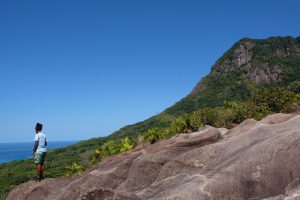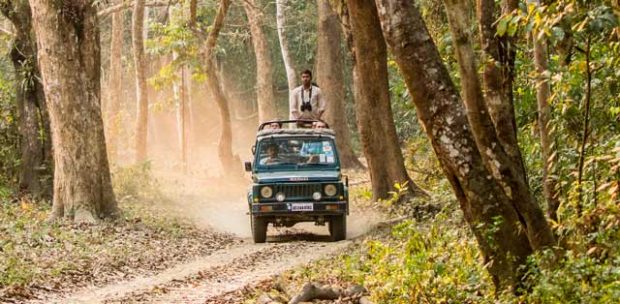
Hiding amid the muddy tracks and long grasses of Assam, the one-horned rhinoceros proves an elusive beast in Kaziranga National Park
View online at natgeotraveller.co.uk
Rain is coming. The tree canopies rustle in anticipation. The long elephant grass starts to sway. Birds burst from high branches, wings fanning through the charged air. “Now,” whispers Babloo from the driver’s seat of our safari jeep. One, two, three seconds later, the downpour hits us on cue. We’ve taken shelter on the edge of a copse where bearded vines loop between the trees like wild doodles. Out on the open floodplains of Kaziranga National Park, rain drenches creation. But here the water just pit-patters over head. It all feels very cosy. Benign. But that’s just an illusion.
“The monsoon is a deadly time,” says Gautam, my young guide. I’ve arrived in late April — the end of the safari season in Kaziranga. The first rains have swollen the Brahmaputra and soon it’ll burst, submerging these flatlands for the summer months. “That’s when the poachers move in,” he tells me gravely. Their target: the horn of the Indian rhino, rhinoceros unicornis, which fetches its weight in gold on the Chinese black market as an aphrodisiac. “How many did we lose last year, Babloo?” “Seven,” the driver answers. Both men nod. It’s a vast improvement on previous years.
With two-thirds of the entire species living in this national park (2,400 at the last count), Kaziranga is the last stronghold of the one-horned rhino. We spot dozens every day, grazing peacefully in far meadows. I watch them through my binoculars, transfixed, until the blood drains from my arms. In a year when the world mourned the death of Sudan — the last male northern white rhino — I’m aware of how precious these sightings are and how rare they might become.
When the downpour peters out, we head off down the muddy track and hit the jackpot: a female rhino grazing alone at the side of the road. It’s my first close encounter. She’s dumpy-looking with a smiling mouth and beedy, myopic black eyes either side of her horn. There’s tufty russet fuzz around her ears that catches the light like a halo. She sniffs the air in our direction. Then she’s off: a cloud of flies pursuing her as she trots back into the bush. The thick skin of her flanks is folded like fearsome plates of armour, except around her pimpled rump where it looks like she’s failed to hike up a pair of saggy bloomers.
Park rangers are stemming the tide of poaching, due to new surveillance drones and an aggressive ‘shoot-on-sight’ policy — in 2015, more poachers were killed than rhinos. But heavier and erratic flooding combined with blocked wildlife corridors mean a number of rhinos drown each year. Gautam dishes out this heartbreaking information with a hopeful caveat: conservationists are hoping to fix this by expanding the park’s boundaries, and rangers are at work building artificial islands on the plain.
Out on the fringe of the park, on our way back to our lodge for lunch, we detour through some of Assam’s famous, electric-green tea plantations and pause in a traditional tribal village of stilt huts. Opposite the village, a couple are wading through a pool each holding the edge of a fishing net, while their children collect fistfuls of water hyacinths. “If they wander off too far… tiger food,” Gautham jokes. I hope he’s referring to the nearby cows.
Kaziranga has fast become my favourite stop in India. But the state of Assam, tucked below Bhutan in a remote northeastern pocket of territory, isn’t on most travellers’ radars — or Indians’. “The people on the ‘mainland’ think we hunt for our food with bows and arrows. Let them, I say,” says Mr Roy, the genteel general manager of Diphlu River Lodge, as he leads me to my river-front cottage upon check in — the same one Prince William stayed in on his visit last year. If the charms of Kaziranga are currently a secret, I suspect it’s one that might get out soon.
In the evening, Gautam, Babloo and I set out for the Western Range of the park before dusk. We stop beside a lake where scimitar-horned buffalo are wallowing nose-deep, surrounded by pelicans and herons. A rhino chomps grass on the far side, attended by a troupe of jungle miners and white carmines that ride on his back. I’m suppressing the urge to jump from the vehicle and run, Mowgli-like, into this wonderland. As the evening sky burns pink and gold, I say a silent prayer for all my new one-horned friends. I hope the sun never sets on the Indian rhino
ESSENTIALS
Diphlu River Lodge offers a Jungle Plan starting at 18,000 INR (£200) including accommodation in one of 12 boutique thatch and bamboo stilt cottages, three meals and two safaris a day (available November to April). A visit to Diphlu River Lodge can be combined with a stay on the houseboat MV Rudra Singha to explore the Brahmaputra River Valley. Transfers to Guwahati Airport (4.5hrs) or Jorhat Airport (2.5hrs) can be arranged at additional cost.
Published in the October 2018 cover story of National Geographic Traveller (UK)





